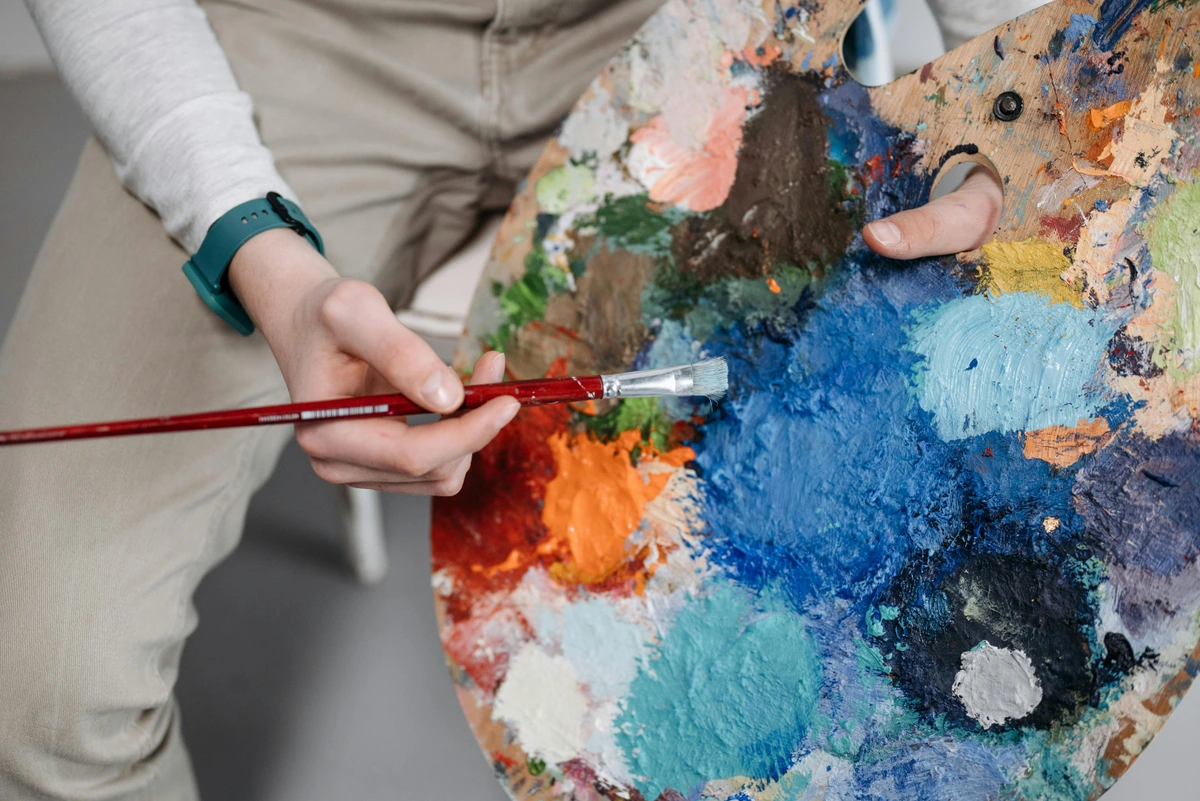
Student Grade vs. Artist Grade Paint: Unpacking the Palette's Secrets
Ever wondered why some paints cost more than others? I'm diving deep into the often-confusing world of student versus artist-grade paints, sharing my personal journey and practical insights to help you choose the right materials for your art, from pigment load to permanence and beyond.
Student Grade vs. Artist Grade Paint: Unpacking the Palette's Secrets
I remember staring at the art store shelves as a budding artist, utterly bewildered. Tubes upon tubes of paint, some ridiculously cheap, others making my wallet whimper just looking at them. "Paint is paint, right?" I thought, probably like many of you are thinking now. Oh, how wrong I was. This isn't just about price tags; it's about the very soul of your art, how it looks, how it lasts, and frankly, how much joy (or frustration) it brings to your creative process.
It took me a while, and a fair few muddy canvases, to truly grasp the profound differences between student-grade paint and artist-grade paint. And let me tell you, understanding this isn't just for the pros; it's foundational for anyone who picks up a brush, whether you're just dabbling or building your masterpiece.

What's the Big Deal, Anyway? Why Does It Matter?
"Why bother?" you might ask. "If I'm just practicing, does it really matter if my paint is professional?" It's a valid question, and one I wrestled with myself. But here's the thing: the quality of your materials directly impacts your learning curve, the vibrancy of your finished work, and even its longevity. Imagine trying to learn to drive in a car with square wheels – you could do it, eventually, but why make it harder on yourself?
Understanding the distinction allows you to make informed choices, saving you money in the long run (yes, really!) and preventing future heartbreak when a cherished piece fades into oblivion. It empowers you to pick the right tool for the job, rather than just grabbing whatever's on sale. And trust me, once you experience the sheer buttery delight of a truly professional pigment, there's no going back.
The Heart of the Matter: Pigment Load (and Why It's a Game-Changer)
This is the big one, the core difference, the whispered secret among artists. When we talk about pigment load, we're talking about how much actual color — pure, unadulterated pigment — is packed into that tube of paint. Think of it like making a strong cup of coffee versus a weak one. Both are coffee, but one delivers a much more intense, rich experience.
- Student-Grade Paint: These paints contain less pure pigment and a higher concentration of fillers (like chalk, clay, or other inert materials) and extenders. This is how manufacturers keep the costs down. The result? Colors that are often less vibrant, less opaque, and can look a bit dull or chalky, especially when mixed. You might find yourself using a lot more paint to achieve the same coverage or intensity, which, ironically, can make them less economical.
- Artist-Grade Paint (or Professional Grade): These are the heavyweights. They boast a much higher pigment concentration, often with fewer or no fillers. The colors are incredibly vibrant, rich, and true. They cover beautifully, a little goes a long way, and they mix like a dream, maintaining their clarity even when blended with other hues. This high pigment density is why they tend to be more expensive, but the payoff in intensity and coverage is undeniable.

This difference in pigment is why I sometimes find myself needing three times as much student-grade red to get the same punch as a tiny dab of artist-grade cadmium red. It's truly a game of diminishing returns if you're not careful. For more on how artists really put color to work, you might want to check out my thoughts on [/finder/page/how-artists-use-color].
Beyond Pigment: The Quality of Everything Else
While pigment is king, it's not the whole kingdom. The other ingredients in your paint tube play crucial roles, impacting everything from how the paint feels on your brush to how long your art will last.
Binders & Fillers
The binder is what holds the pigment particles together and adheres them to your surface. In acrylics, it's an acrylic polymer emulsion; in oils, it's typically linseed oil; in watercolors, it's gum arabic. Just like pigments, binders come in varying qualities.
- Student-Grade: Often use cheaper, less refined binders and, as mentioned, more fillers. This can lead to issues like cracking, uneven drying, or less flexibility over time. It can also affect how the paint accepts acrylic mediums, making some effects harder to achieve.
- Artist-Grade: Utilizes high-quality, professional-grade binders that ensure excellent adhesion, flexibility, and longevity. They contribute to the smooth, rich consistency we all crave.
Permanence & Lightfastness
This one is huge, especially if you want your art to stand the test of time. Permanence refers to the paint's ability to resist fading, discoloration, or chemical changes over time due to exposure to light, humidity, or pollutants. Lightfastness is a specific measure of how well a pigment resists fading when exposed to light.
- Student-Grade: Generally have lower lightfastness ratings. Some pigments, while vibrant initially, might fade or shift in color significantly over a few years, especially if exposed to sunlight. This means your beautiful painting might not look so beautiful a decade from now. For practice or ephemeral work, it's fine, but for anything you want to last, it's a gamble.
- Artist-Grade: Manufacturers prioritize permanence and lightfastness. They use pigments known for their stability and rigorously test them according to standards set by organizations like ASTM (American Society for Testing and Materials). You'll often see ratings (like I, II, III or Excellent, Very Good, Fair) on the tubes, indicating how well the paint will endure. For an example of art that has truly stood the test of time, consider the ancient beauty of a /what-is-encaustic-painting/45ab08c0-90e6-11f0-9119-ffba0f77f014.jpg, a testament to enduring pigments.

Consistency & Texture
Ever squeezed a tube of paint and felt it was... well, a bit weird? That's consistency. This affects how the paint flows, blends, and retains brushstrokes. For insights into mastering different painting techniques, check out the [/finder/page/the-definitive-guide-to-oil-painting-techniques].
- Student-Grade: Can be inconsistent. Some colors might be runny, others stiff. They might feel slightly gummy or watery, making it harder to achieve smooth blends or distinct brush marks. They often don't hold their shape as well for techniques like impasto painting.
- Artist-Grade: Designed for optimal, consistent texture across the range. They often have a rich, buttery feel that responds beautifully to the brush, allowing for effortless blending, sharp details, or expressive impasto. This consistency also impacts how well they layer, which is crucial for building depth in your work (something I discuss in [/finder/page/how-to-layer-colors-in-acrylic-painting]).
The Palette of Possibilities: Color Range & Opacity
Pop into any major art supplier's website or store, and you'll immediately see a stark difference in the sheer breadth of colors available.
- Student-Grade: Tends to offer a more limited range of colors, often relying on hues (mixtures of pigments that approximate a more expensive pigment, like "Cadmium Red Hue" which contains no actual cadmium) rather than pure, single-pigment colors. While these can be fine for basic color mixing, they often lack the depth, clarity, and vibrancy of their pure counterparts, and can sometimes result in muddy mixes.
- Artist-Grade: Provides an extensive array of colors, focusing heavily on single-pigment paints. This is a huge advantage for color mixing, as pure pigments create cleaner, more predictable, and more vibrant blends. You'll also find a wider spectrum of unique and rare pigments. Opacity and transparency are also more reliably labeled and consistent, giving you greater control over your painting's light effects.
The Elephant in the Studio: Cost
Okay, let's talk about the big one: price. Artist-grade paints are undeniably more expensive per tube than student-grade. Your wallet knows it, I know it, we all know it. But here's the thing I've learned, often the hard way: price isn't just about the initial outlay; it's about value and efficiency.
Because artist-grade paints have a higher pigment load, you often use significantly less paint to achieve the same intensity and coverage. A small tube of artist-grade paint can often outlast a larger tube of student-grade if you're aiming for vibrant, opaque results. So, while the upfront cost is higher, the cost-per-use can actually be comparable, or even better, for professional paints. It's like buying a really good tool; it might cost more initially, but it performs better and lasts longer.
When to Reach for Which Tube: My Personal Philosophy
So, with all these differences, when should you use what? My philosophy is pretty straightforward:
- For Beginners & Practice: If you're just starting out, experimenting with new techniques, or doing studies, student-grade paints are your friend. Seriously. There's no need to splurge on professional materials when you're still figuring things out. Get comfortable with the medium, learn about [/finder/page/basic-drawing-techniques-shading-lines], and enjoy the process without the pressure of wasting expensive paint. They're also great for underpaintings or for tasks where archival quality isn't the primary concern.

- For Finished Pieces & Professional Work: When you're creating a piece you want to last, sell, or exhibit, artist-grade paints are essential. The vibrancy, lightfastness, and overall quality will make a tangible difference in the final product and its longevity. This is where you invest in your craft and your legacy. If you're deliberating between brands for professional use, you might find my comparison of [/finder/page/golden-vs-liquitex-which-pro-acrylic-paint-is-right-for-you] insightful.
- Mixing & Matching: Don't be afraid to mix and match! I often use student-grade paint for large washes or background areas where I need a lot of paint and vibrancy isn't paramount. Then, I'll switch to artist-grade for focal points, details, or colors where I need maximum intensity and permanence. Think of it as strategic spending.
Comparison Table: Student vs. Artist Grade Paint
Let's break it down into a handy table for quick reference:
Feature | Student-Grade Paint | Artist-Grade Paint |
|---|---|---|
| Pigment Load | Lower pigment concentration, more fillers | High pigment concentration, few/no fillers |
| Vibrancy/Purity | Less vibrant, can be dull or chalky, often "hues" | Rich, intense, pure colors, often single pigments |
| Lightfastness | Generally lower, prone to fading over time | High, tested for archival quality (ASTM ratings) |
| Consistency | Varies, can be gummy/watery, less consistent | Smooth, buttery, consistent, holds brushstrokes |
| Color Range | Limited palette, many mixed colors | Extensive palette, many pure/unique pigments |
| Opacity/Coverage | Requires more paint for coverage, less opaque | Excellent coverage, strong opacity/transparency |
| Mixing Quality | Can produce muddy mixes, less predictable | Clean, vibrant mixes, predictable results |
| Cost | Lower upfront cost, but can be less efficient | Higher upfront cost, but often more efficient |
| Best Use | Practice, studies, learning, underpaintings | Finished artwork, professional pieces, archival work |
Frequently Asked Questions (FAQ)
Can I mix student and artist-grade paints?
Yes, absolutely! As I mentioned, I do it all the time. Just be aware that mixing them will generally lower the overall quality and lightfastness of the artist-grade paint, diluting its vibrant properties with the student-grade's fillers. It's a compromise, but a useful one for certain applications.
Do all paint types have student and artist grades?
Generally, yes. You'll find this distinction in acrylics, oils (like the comparison between [/finder/page/holbein-vs-winsor-newton-oil-paints]), watercolors, and even gouache. It's a fundamental tier system across most art paint categories.
How can I tell the difference without a label?
If the label is missing or unclear, look for key indicators: the price, of course, is a big hint. Beyond that, squeeze a tiny bit out. Artist-grade paint will generally feel richer, thicker, and more intensely colored straight from the tube. Student-grade might look a bit thinner or have a slight chalky sheen, and certainly won't offer the same depth of color. Sometimes, the series number (e.g., Series 1, 2, 3) also indicates price tiers based on pigment cost within a brand's professional range, but this isn't a student vs. artist distinction in itself.
Is expensive paint always better?
Not necessarily always better for every situation. For learning and practice, expensive paint can be overkill and even intimidating. However, for archival quality, vibrancy, and ease of use in professional work, artist-grade paints generally outperform student grades by a significant margin. It's about suitability for purpose, not just price.
Does student grade paint yellow over time?
This depends on the specific binder and pigments used. While modern student-grade acrylics are less prone to severe yellowing than older oil paints, the cheaper binders and fillers can sometimes contribute to discoloration or lack of clarity over a longer period. Artist-grade paints, with their superior binders and lightfast pigments, are formulated to resist such changes far more effectively.
A Final Brushstroke on Your Journey
Navigating the world of art supplies can feel like a labyrinth, but understanding the core differences between student and artist-grade paints is one of those crucial keys that unlock a smoother, more satisfying creative journey. It's not about snobbery; it's about smart choices that empower your art.
So, go forth! Experiment, paint, and don't be afraid to try both. See what feels right for you and your artistic goals. The magic is in the making, after all. And if you're ever looking for more ways to infuse your life with color, feel free to browse my [/buy] collection or even explore the [/den-bosch-museum] for inspiration from abstract art.





